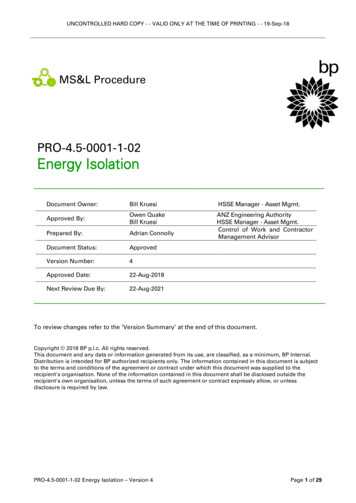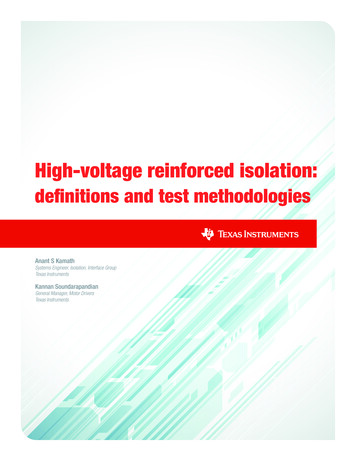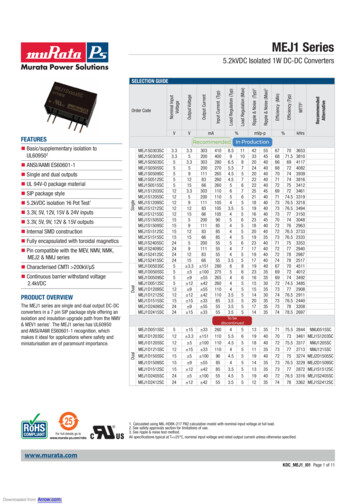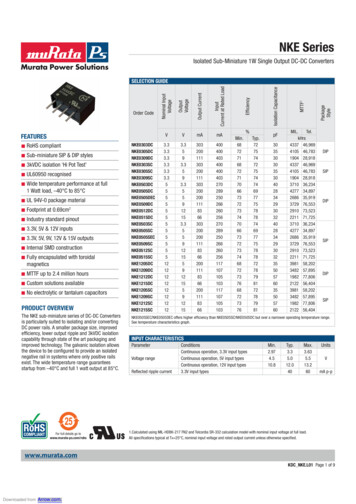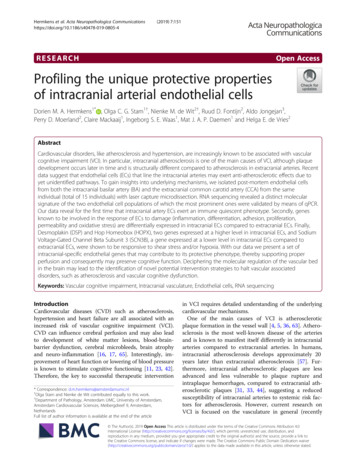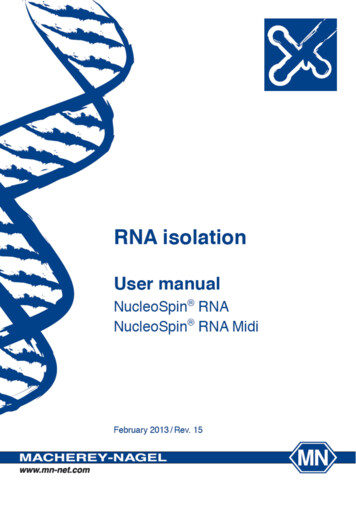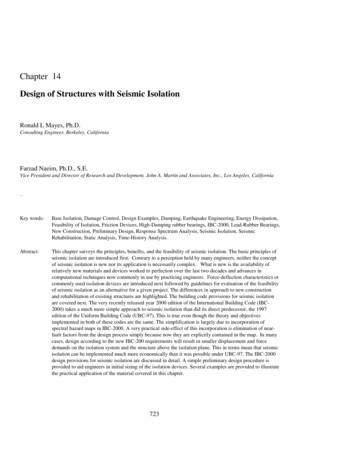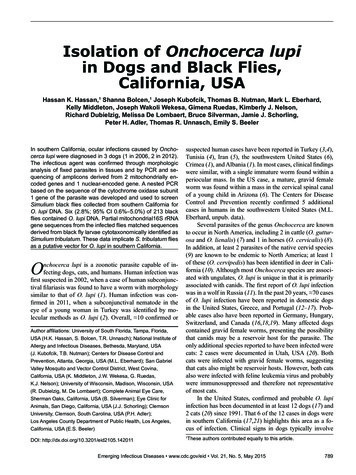
Transcription
Isolation of Onchocerca lupiin Dogs and Black Flies,California, USAHassan K. Hassan,1 Shanna Bolcen,1 Joseph Kubofcik, Thomas B. Nutman, Mark L. Eberhard,Kelly Middleton, Joseph Wakoli Wekesa, Gimena Ruedas, Kimberly J. Nelson,Richard Dubielzig, Melissa De Lombaert, Bruce Silverman, Jamie J. Schorling,Peter H. Adler, Thomas R. Unnasch, Emily S. BeelerIn southern California, ocular infections caused by Onchocerca lupi were diagnosed in 3 dogs (1 in 2006, 2 in 2012).The infectious agent was confirmed through morphologicanalysis of fixed parasites in tissues and by PCR and sequencing of amplicons derived from 2 mitochondrially encoded genes and 1 nuclear-encoded gene. A nested PCRbased on the sequence of the cytochrome oxidase subunit1 gene of the parasite was developed and used to screenSimulium black flies collected from southern California forO. lupi DNA. Six (2.8%; 95% CI 0.6%–5.0%) of 213 blackflies contained O. lupi DNA. Partial mitochondrial16S rRNAgene sequences from the infected flies matched sequencesderived from black fly larvae cytotaxonomically identified asSimulium tribulatum. These data implicate S. tribulatum fliesas a putative vector for O. lupi in southern California.Onchocerca lupi is a zoonotic parasite capable of infecting dogs, cats, and humans. Human infection wasfirst suspected in 2002, when a case of human subconjunctival filariasis was found to have a worm with morphologysimilar to that of O. lupi (1). Human infection was confirmed in 2011, when a subconjunctival nematode in theeye of a young woman in Turkey was identified by molecular methods as O. lupi (2). Overall, 10 confirmed orAuthor affiliations: University of South Florida, Tampa, Florida,USA (H.K. Hassan, S. Bolcen, T.R. Unnasch); National Institute ofAllergy and Infectious Diseases, Bethesda, Maryland, USA(J. Kubofcik, T.B. Nutman); Centers for Disease Control andPrevention, Atlanta, Georgia, USA (M.L. Eberhard); San GabrielValley Mosquito and Vector Control District, West Covina,California, USA (K. Middleton, J.W. Wekesa, G. Ruedas,K.J. Nelson); University of Wisconsin, Madison, Wisconsin, USA(R. Dubielzig, M. De Lombaert); Complete Animal Eye Care,Sherman Oaks, California, USA (B. Silverman); Eye Clinic forAnimals, San Diego, California, USA (J.J. Schorling); ClemsonUniversity, Clemson, South Carolina, USA (P.H. Adler);Los Angeles County Department of Public Health, Los Angeles,California, USA (E.S. Beeler)DOI: http://dx.doi.org/10.3201/eid2105.142011suspected human cases have been reported in Turkey (3,4),Tunisia (4), Iran (5), the southwestern United States (6),Crimea (1), and Albania (1). In most cases, clinical findingswere similar, with a single immature worm found within aperiocular mass. In the US case, a mature, gravid femaleworm was found within a mass in the cervical spinal canalof a young child in Arizona (6). The Centers for DiseaseControl and Prevention recently confirmed 5 additionalcases in humans in the southwestern United States (M.L.Eberhard, unpub. data).Several parasites of the genus Onchocerca are knownto occur in North America, including 2 in cattle (O. gutturosa and O. lienalis) (7) and 1 in horses (O. cervicalis) (8).In addition, at least 2 parasites of the native cervid species(9) are known to be endemic to North America; at least 1of these (O. cervipedis) has been identified in deer in California (10). Although most Onchocerca species are associated with ungulates, O. lupi is unique in that it is primarilyassociated with canids. The first report of O. lupi infectionwas in a wolf in Russia (11). In the past 20 years, 70 casesof O. lupi infection have been reported in domestic dogsin the United States, Greece, and Portugal (12–17). Probable cases also have been reported in Germany, Hungary,Switzerland, and Canada (16,18,19). Many affected dogscontained gravid female worms, presenting the possibilitythat canids may be a reservoir host for the parasite. Theonly additional species reported to have been infected werecats: 2 cases were documented in Utah, USA (20). Bothcats were infected with gravid female worms, suggestingthat cats also might be reservoir hosts. However, both catsalso were infected with feline leukemia virus and probablywere immunosuppressed and therefore not representativeof most cats.In the United States, confirmed and probable O. lupiinfection has been documented in at least 12 dogs (17) and2 cats (20) since 1991. That 6 of the 12 cases in dogs werein southern California (17,21) highlights this area as a focus of infection. Clinical signs in dogs typically involve1These authors contributed equally to this article.Emerging Infectious Diseases www.cdc.gov/eid Vol. 21, No. 5, May 2015789
RESEARCH0.3–0.7-cm periocular masses that contain adult worms.Infections may be associated with additional ocular pathology (Figure 1). The masses are typically subconjunctivalor episcleral but can be found anywhere in the orbit (22).The life cycle of O. lupi, including the vector and its primary reservoir host, remains unknown. Determining the vector is the critical step in preventing exposure. Black flies (Simulium spp.) and biting midges (Culicoides spp.) are vectorsfor other species of Onchocerca (23) and might be vectorsfor O. lupi. Black flies are routinely detected in certain areasof Los Angeles County, including a 29-km stretch of the LosAngeles River (http://www.glacvcd.org/), in the San GabrielValley area (http://sgvmosquito.org/), and in western areasof the county (http://www.lawestvector.org/). We report 3additional O. lupi infections in dogs in southern Californiaand present molecular evidence implicating the black flyspecies S. tribulatum as the possible vector for this parasite.Materials and MethodsIdentification of Cases and ParasitesIn Los Angeles County, the Los Angeles County Department of Public Health conducts animal disease surveillance. Private practice veterinarians report diseases in allspecies, including companion animals. Veterinarians arerequired to report infectious diseases, particularly those listed as being of priority malReportList2013.pdf), as well as anyunusual diseases.In March 2012, a local veterinarian reported a case ofonchocerciasis in a local dog (dog B). Discussions with theveterinary ophthalmologist and the laboratory examiningocular tissue from the dog revealed an earlier case (dog A)and a concurrent case (dog C).In May 2006, a 10-year-old, spayed female Labrador Retriever mix (dog A) was examined by a veterinaryophthalmologist in Los Angeles, California. The dog hada brown, lobulated 16-mm episcleral mass in the lateraltemporal area of the left eye. One week of topical ophthalmologic antimicrobial and corticosteroid therapy failed toshrink the mass, and it was surgically removed. No otherabnormalities were found. The mass contained mixed inflammatory cells surrounding 2 fragments of a cuticle with2 striae per ridge, characteristic of O. lupi. The dog wasfrom the Hollywood Hills area of Los Angeles, 3 kmsouth of the 29-km black fly control zone of the Los Angeles River. A travel history was not available.In February 2012, the same veterinarian examined an8-year-old female spayed Boxer (dog B). The dog had severe bilateral corneal ulcerations, a 10-mm conjunctivalmass in the nasodorsal area of the right eye, and persistent mydriasis in the left eye. No other abnormalities werefound. Corneal ulceration is a common disorder in Boxers,790Figure 1. Right eye of a dog with Onchocerca lupi infection,southern California, USA, 2004. The dog had severe conjunctivalinflammation, corneal degeneration, and an elevated intraocularpressure of 31 mm Hg. Ultimately, enucleation was performed,and histology revealed Onchocerca adult worms.but the mass was considered to be unrelated to the ulcers(24). The mass was surgically removed and the ulcers treated surgically and medically. The mass contained multifocalgranulomatous nodules with central necrosis surroundingsections of partially mineralized nematodes with 2 striaeper ridge, characteristic of O. lupi. The dog lived in the SanFernando Valley area of Los Angeles, within 5 km of theblack fly control zone of the Los Angeles River. It had livedin the Los Angeles area all of its life.In January 2012, a 4-year-old pit bull mix (dog C) wasexamined by a veterinary ophthalmologist in San Diego.The dog had 2 episcleral masses (10 mm and 5 mm) at thelateral limbus of the left eye. The masses were immediately adjacent to each other and were associated with thelateral rectus muscle. No other abnormalities were found.The masses were surgically removed, and O. lupi was identified morphologically in the tissues. The dog was living ata humane society in San Diego, and further history on thedog was not available.Molecular Characterization of Parasite SamplesUnstained, formalin-fixed, paraffin-embedded tissuescontaining the parasite were obtained from each of the 3dogs. DNA was extracted by using a kit designed for purification of DNA from formalin-fixed paraffin-embeddedtissue (QIAamp DNA FFPE Tissue Kit; QIAGEN, Valencia, CA, USA) according to the manufacturer’s instructions. DNA was then amplified by using each of 3 sets ofprimers targeting highly conserved nematode or filarialspecies. This set included primers for the internal transcribed spacer (ITS) in the 5S rRNA gene: (S2: 5′-GTTAAGCAACGTTGGGCCTGG-3′; S16: 5′-TTGACAGATCGGACGAGATG-3′) the 12S small subunit rRNA gene ofEmerging Infectious Diseases www.cdc.gov/eid Vol. 21, No. 5, May 2015
Onchocerca lupi, Californiathe mitochondrion (12SF: 5′-GTTCCAGAATAATCGGCTA-3′, 12SR: 5′-ATTGACGGATGRTTTGTACC-3′),and cytochrome oxidase I (COI; COIF: 5′-TGATTGGTGGTTTTGGTAA-3′, COIR: 5′-ATAAGTACGAGTATCAATATC-3′), as described previously (25,26). PCR products were cloned into the TOPO-TA plasmid vector (LifeTechnologies, Grand Island, NY, USA) according to themanufacturer’s instructions, and plasmids were preparedand sequenced in both directions by using TOPO-specificprimers as described previously through a commercial service (Macrogen, Gaithersburg, MD, USA). DNA sequenceswere initially analyzed using BLAST (http://blast.ncbi.nlm.nih.gov/Blast.cgi). Sequence alignments were performedusing ClustalW (27), and an unrooted phylogenetic reconstruction was performed using the neighbor-joining methodfollowed by bootstrap analysis using the MegAlign V11routine of the DNAStar program package (DNAStar, Madison, WI, USA). Sequences were submitted to GenBank withthe following accession numbers: KC763786, KC763785,KC763784, KC763783, KC763782, KC763781, KC763780,KC763779, and JX489168.475 bp. A total of 1 μL of the product of the first reactionwas used as the template in the nested reaction, which usedthe buffer conditions described above and primers with thesequences 5′-TCAAAATATGCGTTCTACTGCTGTG-3′and 5′-CAAAGACCCAGCTAAAACAGGAAC-3′. Cycling conditions consisted of 94 C for 4 min, followed by40 cycles of 94 C for 45 s, 50 C for 45 s, and 72 C for 90s, and a final extension of 72 C for 10 min. This reactionproduced an amplicon of 115 bp. Products from the nested reaction were analyzed by electrophoresis on a 1.5%agarose gel. Samples producing a band of the appropriatesize in the initial screens (115 bp) were subjected to a second independent PCR. Samples producing products of theexpected size were considered as putative positives. Amplicons of putative positives were subjected to DNA sequence analysis to confirm the identity of the product, using a commercial service (Genewiz, South Plainfield, NJ,USA). We calculated 95% CIs surrounding the estimateof the proportion of infected flies using standard statisticalmethods (28).Black Fly Collection and ProcessingWe amplified a portion of the mitochondrial 16S rRNAgene from the DNA prepared from the infected flies, following previously published protocols (29). The primersused in the amplification reaction were 16S F: 5′-CGCCTGTTTATCAAAAACAT-3′ and 16S R: 5′-CTCCGGTTTGAACTCAGATC-3′. The resulting amplicons were subjected to DNA sequence analysis, as described above. TheDNA sequences obtained were submitted to the GenBanksequence database under accession numbers KP233211and KP233212.Black fly larvae were collected from 4 sites near the locations where the infected flies were trapped. The isolatedlarvae were cut in half horizontally immediately upon collection. The anterior end of each larva (head) was fixed in70% isopropanol (rubbing alcohol), and the posterior end(abdomen) was fixed in Carnoy’s solution (3 parts 95%ethanol and 1 part glacial acetic acid by volume).DNA was prepared from the heads of the fixed larvaeand used to amplify the portion of the mitochondrial 16SrRNA gene, as described above. The abdomen of eachlarva was opened ventrally with fine needles and stainedwith the Feulgen method (30). Salivary glands with stainednuclei and 1 gonad for sex determination were dissectedfrom the abdomen, placed in a drop of 50% acetic acid, flattened under a coverslip, and examined with oil immersion.Identifications were based on diagnostic species-specificrearrangements of the polytene chromosomes (31,32).During April–August 2013, we collected 248 black fliesfrom 13 locations in the San Gabriel Valley in Los AngelesCounty throughout an area 380 km2. This area is 40-50km east of the veterinary clinic that diagnosed O. lupi infection in dogs A and B and 180 km north of the clinicthat diagnosed it in dog C. The area contains the watershedof the San Gabriel River. The convenience sample of blackflies was caught in CO2-baited encephalitis virus surveillance traps that had been set for mosquito collection. Eachfly was identified as belonging to the Simulium genus bystandard taxonomic keys and was fixed in 70% ethanol.We prepared DNA from the individual flies by usingthe DNeasy Blood and Tissue Kit (QIAGEN) following themanufacturer’s instructions. Flies were prepared in batchesof 12 samples; each batch contained 10 individual flies and2 sham extractions that served as negative controls. A total of 2 μL of the purified genomic product was then usedas a template in a nested PCR targeting the O. lupi CO1gene. All PCRs were conducted in a total volume of 50μL. The initial amplification reaction was conducted in asolution of 300 mmol/L Tris-HCLl (pH 9.0); 75 mmol/L(NH4)2SO4; 10 mmol/L MgCl2; 200 µmol/L each of dATP,dCTP, dGTP, and dTTP; 0.5 mM of each primer, and 2.5U of Taq DNA polymerase (Invitrogen). Primer sequencesemployed in the initial reaction were 5′-TGTTGCCTTTGATGTTGGGG-3′ and 5′-GGATGACCGAAAAACCAAAACAAG-3′, and amplification conditions were94 C for 3 min, followed by 35 cycles of 94 C for 45 s,52 C for 30 s, and 72 C for 90 s, with a final extension of72 C for 10 min. This reaction produced an amplicon ofFly IdentificationResultsUnstained, formalin-fixed, paraffin-embedded tissue fromthe 3 dogs was used to amplify parts of 2 mitochondria-Emerging Infectious Diseases www.cdc.gov/eid Vol. 21, No. 5, May 2015791
RESEARCHencoded (CO1 and 12S rRNA) and 1 nuclear-encoded(rRNA ITS1) genes. On the basis of the alignments andphylogenetic analyses, each parasite isolated from the 3dogs was shown unequivocally to be O. lupi. For example,the sequences obtained from the ITS1 amplicon from theparasites from each dog were close to 100% identical to anO. lupi isolate from Hungary (Figure 2). Identical relationships were obtained when the 12S rDNA and CO1 PCRamplicons were analyzed (online Technical AppendixFigures 1, 2, pp1.pdf).Of the 248 individual black flies collected, 213 werescreened using the nested PCR targeting the O. lupi CO1gene. Of these, 6 (2.8%; 95% CI 0.6%–5.0%) producednested amplicons of the expected size of 115 bp. The sequences of all 6 amplicons exactly matched the published O.lupi CO1 sequence (data not shown). We then attempted torecover the amplicon from the first reaction and determinethe DNA sequence of this larger fragment. This attemptwas successful in 4 of the 6 positive flies, resulting in 399bp of sequence between the primer sites. The sequenceof the recovered amplicons matched that of the GenBankreference sequence almost exactly in all 4 samples (Figure3). We noted single-nucleotide polymorphisms in 3 of the4 amplicons when we compared them with published sequence; 2 of the isolates shared 1 polymorphism (Figure 3).Of the 13 locations sampled, 5 contained positive flies(online Technical Appendix Figure 3); 1 location had 2positive flies (Table). These 5 locations spanned 270 km2,covering most of the sampled area, except its northwestcorner. Of the 5 positive sites, 4 were within a circle witha radius of 17.5 km (online Technical Appendix Figure 3).Three of the 5 positive collection sites were located alongthe San Gabriel River (online Technical Appendix Figure3). All positive flies were collected during the spring (April22–June 4, 2013).Figure 2. Molecular identificationof parasites collected from 3dogs in southern California,USA, by using sequence fromthe rRNA internal spacer (ITS).A) Multiple sequence alignmentof ITS sequences from the3 dogs and sequences fromvarious Onchocerca parasites.Gray shading indicates areas ofsequence identity. B) Unrootedphylogeny of the sequencesshown in panel A. Numbers referto the percentage of times thegrouping distal to the number wassupported in a bootstrap analysisof 1,000 replicate datasets.GenBank accession numbersfor the sequences used in thealignment and phylogeny were asfollows: O. lupi, JX489168; dogB, KC763782; dog C, KC763781;dog A, KC763779; O. ochengi,DQ523781; O. cervicalis, U13678;O. volvulus, AF325546. Scale barindicates nucleotide substitutionsper 100 residues.792Emerging Infectious Diseases www.cdc.gov/eid Vol. 21, No. 5, May 2015
Onchocerca lupi, CaliforniaFigure 3. Sequence of theOnchocerca lupi cytochromeoxidase subunit 1 geneamplicons recovered frominfected flies, southernCalifornia, USA, 2012. Grayshading indicates areas ofsequence identity.Labels referto the sample number of theindividual infected files fromwhich the sequences wereobtained. O. lupi GenBankaccession no. KC763786. LAC,Los Angeles County.To determine the identity of the infected flies, we amplified a portion of the black fly mitochondrial 16S rRNAgene from the remaining DNA samples. This sequence haspreviously been shown to be phylogenetically informative in distinguishing several North American black flyspecies (29). A comparison of the sequence data obtainedfrom the amplicons with the GenBank sequence databaseshowed that the sequences were most similar to members of the genus Simulium; however, an exact match wasnot obtained to any of the sequences in GenBank, whichprecluded identification of the infected flies to the specieslevel (data not shown). To identify the flies to the specieslevel, we collected black fly larvae from sites near the locations from which the infected flies were trapped (onlineTechnical Appendix Figure 3). These larvae were bisectedand preserved for molecular and cytotaxonomic analyses.The diagnostic portion of the 16S rRNA gene was thenamplified from the collected larvae and compared with thesequences obtained from the infected flies. Larvae that hadsequences matching those of the infected flies exactly wereEmerging Infectious Diseases www.cdc.gov/eid Vol. 21, No. 5, May 2015793
RESEARCHTable. Species identification of Onchocerca lupi –infected flies, southern California, USA, 2012Infected fly no.Collection dateLocationLatitudeLongitudeLAC 3-22013 Apr 22Monterey Park City Yard34.05341 118.116537LAC 5-12013 Apr 24Bernard Biostation34.116667 117.7125LAC 7-452013 Apr 29Walnut Coop34.029101 117.854616LAC 12-262013 May 7Rainbow Canyon Ranch34.144731 117.935686LAC 17-52013 Jun 4Santa Fe Dam34.116667 117.95LAC 17-182013 Jun 4Santa Fe Dam34.116667 117.95*LAC, Los Angeles County; ND, definitive identification not successful.then identified by cytotaxonomy. Of the 6 infected flies, 5were identified as S. tribulatum using this process (Table).Two 16S mitochondrial alleles were identified in the population of larvae and infected flies identified as S. tribulatum.These were designated S. tribulatum A and S. tribulatumB, which were 97% similar to one another (online Technical Appendix Figure 4). S. tribulatum B was identified inthe infected flies from the Santa Fe Dam, whereas infectedflies from the Monterey Park City Yard, Bernard Biostation, and Walnut Coop contained S. tribulatum A (Table).The sequence of the infected fly from Rainbow CanyonRanch matched that of 1 larva in the collection; however,definitive cytotaxonomic identification of this larva was notsuccessful because of poor fixation.DiscussionOur data imply that O. lupi infection in dogs is ongoingin southern California. The possibility that dogs might beserving as sentinels for this infection suggests that humansand cats in the area also could be at risk for infection.Several other Onchocerca species are endemic toNorth America. However, except for O. lupi, all of theseare known to use ungulates as their primary hosts. Thus,isolation of these parasites from dogs, together with thephylogenetic analysis of 3 different gene sequences that allgroup the isolates with O. lupi, strongly support the identification of these parasites as O. lupi.The nested PCRs detected CO1-derived ampliconswith sequences 99.5%–100% identical to the publishedO. lupi CO1 sequence in 6 flies. Some of these sequencescould be derived from other Onchocerca because Simuliumspp. flies are known to be vectors for several Onchocercaspecies for which sequence data are not available (33,34).However, previous studies have suggested that sequencevariation in the mitochondrial genome varies from 7% to15% among Onchocerca species (9,35), and intraspeciesvariation within the mitochondrial genome is limited in thegenus Onchocerca (9,35). Therefore, the sequences detected in the flies are unlikely to have derived from a speciesother than O. lupi.Our data suggest that the black flies collected frequently fed on a host species that was infected with O. lupi, ahost that remains unidentified. However, our data implicateS. tribulatum flies as the vector for O. lupi in southern California. S. tribulatum, a member of the S. vittatum species794Species and genotype*Simulium tribulatum AS. tribulatum AS. tribulatum ANDS. tribulatum BS. tribulatum Bcomplex, is one of the most abundant and widespread species of Simulium flies in North America (36). S. tribulatum flies generally feed on large mammals (e.g., cattle orhorses) and rarely bite humans (36).The implication of S. tribulatum flies as a possible vector for O. lupi also might provide insight about the reasons that O. lupi cases have primarily been found in thesouthwestern United States. Cities and human settlementsthere typically rely on anthropogenic water sources, such asaquifers, reservoirs, and other water impoundments. The S.vittatum complex (of which S. tribulatum is a member) includes some of the few black fly species in North Americathat prosper in these environments (36).The assay we used to detect O. lupi in the black fliescannot distinguish between viable and nonviable parasitesor immature and infective larvae. Thus, although our dataimplicate S. tribulatum flies as the vector, additional studies are needed to confirm this hypothesis. Laboratory colonies of S. vittatum, a sibling species of S. tribulatum, couldprove useful in confirming that flies of this species complexare actually competent vectors for this parasite (37).The black flies that tested positive for O. lupi camefrom geographic locations adjacent to the San GabrielRiver and its watershed. During the past 20 years, southern California has tried to restore natural watershed andwetland habitats, including those in the San Gabriel Valleyarea (38). Black flies rely on rivers and other bodies of water, often with aquatic vegetation for egg laying and larvaldevelopment, all of which the San Gabriel River and LosAngeles River watersheds provide.The San Gabriel Mountains are directly upstream ofthe sites from which we collected the larvae and positiveflies. The San Gabriel River, its watershed, and its recreational areas are likely to be providing a wildlife corridorthat enables an easily accessible transmission interface.Although most cases in canids have been described in domestic dogs, the relative rarity of infections in domesticanimals suggests that the parasite uses a different speciesas its primary reservoir. The ubiquitous presence of coyotesand other nondomestic canids in the San Gabriel watershedmight provide a convenient natural reservoir for the parasite. Additional studies involving sampling of the coyotepopulation in the area, coupled with molecular identification of the blood meals taken by the local black flies (39),would be useful in resolving these questions.Emerging Infectious Diseases www.cdc.gov/eid Vol. 21, No. 5, May 2015
Onchocerca lupi, CaliforniaPrevention of O. lupi infection ultimately might rely oneffective Simulium control programs, which must addressblack fly breeding in a variety of settings. The most effective control methods used for the past 20 years in the SanGabriel Valley have been applications of VectoBac 12AS(Bti) (K. Fujioka, San Gabriel Valley Mosquito and VectorControl District, pers. comm.) and occasionally stoppingthe flow of water for a minimum of 48 hours because thelarvae are vulnerable to desiccation (40). The role of ivermectin, milbemycin, and other heartworm preventive medications commonly used in dogs and cats is unknown. Thesemedications would probably kill microfilariae, but their efficacy against infective L3 larvae of O. lupi is unknown.These medications in pets may play a role in preventinginfection or in preventing infected pets from serving as reservoir hosts, reducing transmission of this infection.8.9.10.11.12.This study was funded in part by the Division of IntramuralResearch, National Institute of Allergy and Infectious Diseases,National Institutes of Health (J.K. and T.B.N.).13.S.B. worked on this project in partial fulfillment of her Master ofScience in Public Health degree at the University ofSouth Florida.14.Mr. Hassan is a research associate in the Department of GlobalHealth at the University of South Florida. His research interestsfocus on the development of novel diagnostic tests for, and theecology of, vector-borne diseases, with an emphasis on humaninfections with Onchocerca spp.15.References17.1.2.3.4.5.6.7.Sréter T, Széll Z, Egyed Z, Varga I. Subconjunctival zoonoticonchocerciasis in man: aberrant infection with Onchocerca lupi?Ann Trop Med Parasitol. 802125001267Otranto D, Sakru N, Testini G, Gurlu VP, Yakar K, Lia RP,et al. Case report: first evidence of human zoonotic infection byOnchocerca lupi (Spirurida, Onchocercidae). Am J Trop Med Hyg.2011;84:55–8. http://dx.doi.org/10.4269/ajtmh.2011.10-0465Ilhan HD, Yaman A, Morishima Y, Sugiyama H, Muto M,Yamasaki H, et al. Onchocerca lupi infection in Turkey: a uniquecase of a rare human parasite. Acta Parasitol. 13-0152-8Otranto D, Dantas-Torres F, Cebeci Z, Yeniad B, Buyukbabani N,Boral OB, et al. Human ocular filariasis: further evidence on thezoonotic role of Onchocerca lupi. Parasit Vectors. Mowlavi G, Farzbod F, Kheirkhah A, Mobedi I, Bowman DD,Naddaf SR. Human ocular onchocerciasis caused byOnchocerca lupi (Spirurida, Onchocercidae) in Iran. J Helminthol.2014;88:250–5. d ML, Ostovar GA, Chundu K, Hobohm D, Feiz-Erfan I,Mathison BA, et al. Zoonotic Onchocerca lupi infection in a22-month-old child in Arizona: first report in the United States anda review of the literature. Am J Trop Med Hyg. -0733Ferenc SA, Copeman DB, Turk SR, Courtney CH. Onchocercagutturosa and Onchocerca lienalis in cattle: effect of age, sex, and16.18.19.20.21.22.23.24.origin on prevalence of onchocerciasis in subtropical and temperateregions of Florida and Georgia. Am J Vet Res. 1986;47:2266–8.Cummings E, James ER. Prevalence of equine onchocerciasis insoutheastern and midwestern United States. J Am Vet Med Assoc.1985;186:1202–3.McFrederick QS, Haselkorn TS, Verocai GG, Jaenike J. CrypticOnchocerca species infecting North American cervids, withimplications for the evolutionary history of host associations inOnchocerca. Parasitology. 2013;140:1201–10. n CJ, Anderson JR, Longhurst WM, Connolly G.Filarial worms of Columbian black-tailed deer in California. 1.Observations in the vertebrate host. J Wildl Dis. 8-9.3.213Rodonaja TE. A new species of nematode, Onchocerca lupi n. sp.from Canis lupus cubanensis. Soobshchenyia Akad NaukGruzinskoy USSR. 1967;45:715–9.Sréter-Lancz Z, Széll Z, Sréter T. Molecular genetic comparison ofOnchocerca sp. infecting dogs in Europe with other spiruridnematodes including Onchocerca lienalis. Vet Parasitol.2007;148:365–70. nto D, Dantas-Torres F, Giannelli A, Latrofa MS,Papadopoulos E, Cardoso L, et al. Zoonotic Onchocerca lupiinfection in dogs, Greece and Portugal, 2011–2012. Emerg InfectDis. 2013;19:2000–3. http://dx.doi.org/10.3201/eid1912.130264Komnenou A, Egyed Z, Sreter T, Eberhard ML. Canineonchocercosis in Greece: report of further 20 cases and molecularcharacterization of the parasite and its Wolbachia endosymbiont.Vet Parasitol. 2003;118:151–5. oss MK, Dubielzig RR, Eberhard ML, Schmidt KS.Canine ocular onchocerciasis in the United States: two new casesand a review of the literature. Vet Ophthalmol. 4.2005.00348.xFaísca P, Morales-Hojas R, Alv
The dog lived in the San Fernando Valley area of Los Angeles, within 5 km of the black fly control zone of the Los Angeles River. It had lived in the Los Angeles area all of its life. In January 2012, a 4-year-old pit bull mix (dog C) was examined by a veterinary ophthalmologist in San Diego. The dog had 2 episcleral masses (10 mm and 5 mm) at the

